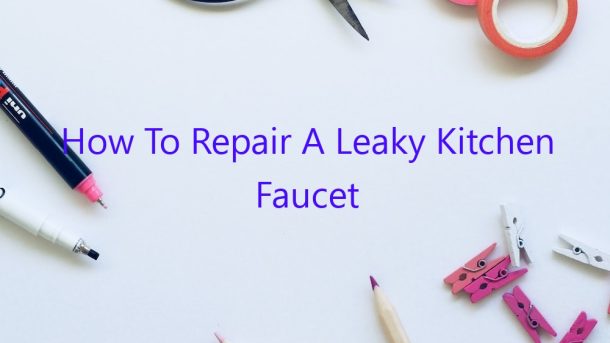If you’re like most people, your kitchen faucet gets a lot of use. So it’s not surprising when it starts to leak. A leaky kitchen faucet can be a nuisance, wasting water and costing you money. But it’s a problem that can easily be fixed.
There are several things you can do to repair a leaky kitchen faucet. The most common causes of leaks are a worn-out gasket or washer. So the first thing you should do is check these parts for signs of wear and tear.
If the gasket or washer is worn, you can replace them yourself. Just follow the instructions in your faucet’s manual. Be sure to use the right type of gasket or washer, or you could end up with another leak.
If the gasket or washer is not the problem, you may need to tighten the faucet’s screws or nuts. Sometimes, when the faucet is tightened too much, the seals can become damaged and leaks can develop. So be sure to only tighten the screws or nuts a few turns at a time, and then check to see if the leak has stopped.
If the screws or nuts are not the problem, the faucet may need to be replaced. This is a more complicated task and may require the help of a professional.
If your kitchen faucet is leaking, don’t wait to fix it. A small leak can quickly turn into a big one. Fixing a leaky kitchen faucet is an easy task, and it will save you water and money.
Contents [hide]
How do I stop my kitchen faucet from dripping?
If your kitchen faucet is dripping, you’re not alone. A dripping faucet can waste gallons of water each day, costing you money in the long run. Fortunately, there are several ways to stop your kitchen faucet from dripping.
One way to stop a kitchen faucet from dripping is to replace the washer. The washer is the small, rubber disk that sits inside the faucet and seals the watertight joint between the faucet body and the spout. If your washer is worn or damaged, it may be causing the faucet to drip. To replace the washer, remove the faucet handle and the bonnet nut that holds the faucet body in place. The washer will be sitting inside the faucet body. Remove the washer and replace it with a new one. Reattach the faucet handle and the bonnet nut.
If replacing the washer doesn’t stop your kitchen faucet from dripping, you may need to replace the entire faucet. Faucets wear out over time and may start to drip due to a loose connection or a worn-out valve. To replace a kitchen faucet, remove the old faucet and install the new one. Be sure to read the installation instructions carefully to ensure that you install the faucet correctly.
If you’re not comfortable replacing the kitchen faucet on your own, you can call a plumber to do it for you. Plumbers can be expensive, but they can help you get the job done quickly and correctly.
If you’re having trouble stopping your kitchen faucet from dripping, try one of these methods. You may be able to save yourself some money and water in the process.
What causes a dripping kitchen faucet?
Water dripping from a kitchen faucet can be quite annoying. But what causes this problem in the first place? There are several possible reasons.
One common cause of a dripping kitchen faucet is a worn-out washer. This is a small rubber disk that helps seal the faucet and stop water from leaking. If the washer is old and worn out, it may not be able to seal the faucet properly, causing water to drip.
Another common cause of a dripping kitchen faucet is a leaky valve. This is a metal disk inside the faucet that regulates the flow of water. If the valve is leaky, it may not be able to stop the water from flowing, which can cause the faucet to drip.
In some cases, the problem may not be with the faucet itself, but with the waterline. If the waterline is cracked or corroded, it may not be able to carry the water properly, which can cause the faucet to drip.
If you’re experiencing a dripping kitchen faucet, the best thing to do is to call a plumber. He or she will be able to identify the cause of the problem and fix it.
Why does my faucet drip after I turn it off?
Most people have experienced a faucet that drips after being turned off. This is a common issue that can have several different causes. In this article, we will explore the most common reasons why a faucet might drip after being turned off.
One of the most common reasons for a faucet to drip after being turned off is a worn-out washer. If the washer is not sealing properly, it can cause water to drip out of the faucet. The best way to fix this is to replace the washer.
Another common reason for a faucet to drip after being turned off is a leaking valve. If the valve is not sealing properly, it can cause water to drip out of the faucet. The best way to fix this is to replace the valve.
A third common reason for a faucet to drip after being turned off is a clogged aerator. If the aerator is clogged, it can cause water to drip out of the faucet. The best way to fix this is to clean the aerator.
If none of the above reasons seem to be the cause of your faucet’s dripping, it might be a sign that you need to have your faucet repaired or replaced. Contact a plumber to have your faucet looked at to determine the cause of the drip.
How do you fix a dripping kitchen faucet with two handles?
A dripping kitchen faucet wastes water and money. It can also be a sign that there is a problem with the faucet. Fixing a dripping kitchen faucet is a simple task that most people can do themselves.
There are a few different ways to fix a dripping kitchen faucet. The most common way is to replace the washer. The washer is the part of the faucet that wears out over time and causes the faucet to leak.
To replace the washer, you will need to remove the handle of the faucet. This is usually done by turning the handle counterclockwise. Once the handle is removed, you will be able to see the washer. The washer is a small, rubber disk that is located in the center of the faucet.
To remove the washer, you will need to use a screwdriver to pry it out. Be careful not to damage the washer. Once the washer is removed, you can replace it with a new one.
Replace the washer by placing it in the center of the faucet and pressing it down. Once the washer is in place, replace the handle of the faucet by turning it clockwise.
If the washer is not the problem, you may need to replace the entire faucet. This is a more difficult task and may require the assistance of a professional.
If your kitchen faucet is dripping, try replacing the washer. If the washer does not fix the problem, you may need to replace the entire faucet.
What is the most common cause of a dripping faucet?
When a faucet drips, it can be a nuisance. But it can also be a sign that there is a problem that needs to be fixed. So what is the most common cause of a dripping faucet?
There are a few different things that can cause a faucet to drip. One of the most common causes is a worn-out washer. When the washer wears out, it can’t create a tight seal, which causes water to leak out. Another common cause of a dripping faucet is a leaky valve. A leaky valve can let water escape even when the faucet is turned off. And finally, a loose faucet can also cause a faucet to drip. If the faucet isn’t tightened properly, it can move around and let water escape.
If your faucet is dripping, the best thing to do is to figure out what is causing the problem. You can do this by checking the washer, the valve, or the faucet itself. If you determine that the problem is with the washer or the valve, you can usually fix it by yourself. But if you determine that the problem is with the faucet, you may need to call a plumber.
So what is the most common cause of a dripping faucet? In most cases, it’s a worn-out washer. If your faucet is dripping, be sure to check the washer and see if it needs to be replaced.
Why a leaking tap should be repaired immediately?
A dripping tap may not seem like a big deal, but it can actually waste a lot of water and money over time. Here are four reasons why you should repair a leaking tap as soon as possible:
1. A leaking tap can waste a lot of water.
A dripping tap can waste hundreds of gallons of water per month. That’s money down the drain!
2. A leaking tap can damage your plumbing.
If a tap leaks for long enough, it can cause significant damage to your plumbing. Leaking taps can also cause mold growth.
3. A leaking tap can lead to water shortages.
A leaking tap can contribute to water shortages, especially during times of drought.
4. A leaking tap can be a safety hazard.
A leaking tap can be a safety hazard, especially if it’s near a staircase. A small leak can turn into a big mess if not repaired quickly.
If you have a leaking tap, don’t wait – call a plumber and get it fixed!
Can you change a faucet without turning the water off?
The answer to this question is yes, you can change a faucet without turning the water off. This is a handy skill to know if you ever need to repair or replace a faucet.
The first thing you will need to do is locate the shut-off valve for the faucet you are working on. This is typically a lever located underneath the faucet. Once you have located the shut-off valve, you can turn it off to stop the flow of water.
Once the water is turned off, you can proceed to replace or repair the faucet. Make sure to turn the water back on after you are finished, so you can test the faucet for leaks.




